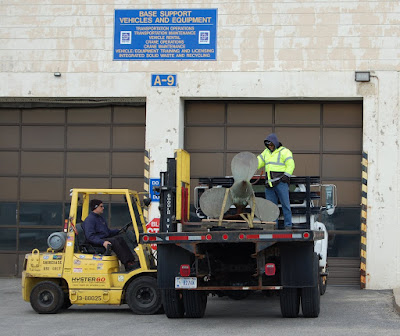Submarine Propeller Returns Home to Newport
 |
L-8 propeller arriving at Naval Station Newport
Photo by Liz DeLucia, Director of Education
|
File this under “Not Something You See Everyday!” Last month
we received a call from the president of CONUSUB, a commercial diving company,
about a unique artifact in his possession. He and several of his associates had
recovered a propeller from the wreck of an early twentieth-century American
submarine, and he wanted to find a good home for it.
 |
The team that recovered the propeller from the L-8 wreck site
L-R: Stephen Moy, Eva Longobardi, Kenny Sheehan, Donald Gunning, Greg DeAscentis
|
The submarine, L-8, was sunk for target practice in
Narragansett Bay in 1926, so it has a strong connection with our local history
here in Newport. While we were eager to receive the propeller for our
collection, the logistics of getting it from downtown Newport to the museum
proved to be a challenge. Fortunately the facilities crew of Naval Station
Newport stepped in to help and transported the propeller to our storage facility.
 |
| Photo by Liz DeLucia, Director of Education |
Its next stop is the Navy’s conservation labs in Washington
DC where it will undergo cleaning and treatment in order to prepare it for
display. Thank you to the members of the facilities crew for their outstanding
work in making this happen!
L-8 was laid down on 24 February 1915 at the
Portsmouth Navy Yard in New Hampshire and launched on 23 April 1917. The L-class was the product of the U.S.
Navy’s first attempt at building ocean-going submarines. L-8 had a range of 4,500 nautical miles with a top speed of 14
knots on the surface and 10.5 knots submerged. She carried eight torpedoes
(four in bow tubes and four reloads) and was also armed with a retractable three-inch
deck gun.
 |
L-8 in dry dock at the Portsmouth Navy Yard, Kittery, Maine, 1917
NH 51135 Naval History & Heritage Command |
Following training operations along the east coast, L-8 steamed
for the Azores in November 1918 to join Submarine Division 6 in anti-submarine
patrols during the World War I. She arrived in Bermuda on 13 November only to
discover that the armistice had taken effect two days earlier, and was ordered
to return to the United States.
 |
A torpedo armed with a magnetic influence exploder passes
under L-8 during tests conducted on 26 May 1926
NH 88457
Naval History & Heritage Command
|
The following year, L-8 joined the
submarine flotilla on the west coast. There she conducted experimented with new
torpedoes and undersea detection equipment. She returned to the east coast in
1922 and arrived at Hampton Roads where she was decommissioned on 15 November.
But the Navy wasn’t finished with her quite yet. L-8’s final destination was Newport, Rhode
Island, where she was turned over to the Naval Torpedo Station for
testing. On 26 May 1926, L-8 was destroyed
as a target to test the effectiveness of the Navy’s new magnetic influence
exploders for torpedoes. This was the only test with live torpedoes of magnetic
exploders conducted by the Navy before World War II.
 |
L-8 sinks after a successful hit
NH 88458
Naval History & Heritage Command
|
Rob Doane
Curator, Naval War College Museum


The photo that says it was possibly at New London was really taken at the Portsmouth, NH Naval Shipyard. Note the circular structure at the top of the photo. This can be seen in other photos taken at the main drydock at Portsmouth NSY.
ReplyDeleteJohn, thank you for catching that! The caption has been updated.
Delete